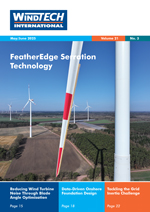KIER advances large-scale wind blade design with new platform and research facility – Windtech International

Development of Full-Cycle Research Infrastructure for Large Wind Turbine Blades in Korea
Introduction
The Wind Energy Research Department at the Korea Institute of Energy Research (KIER), under the leadership of Director Cheol Yoo, has successfully developed a comprehensive design platform and supporting research infrastructure aimed at advancing domestic development of large wind turbine blades. This initiative aligns with the Sustainable Development Goals (SDGs), particularly SDG 7 (Affordable and Clean Energy) and SDG 9 (Industry, Innovation, and Infrastructure).
Current Challenges in Wind Turbine Blade Development
- Korea’s localisation rate for core wind turbine components remains approximately 34%.
- For turbines exceeding 10MW, blade design and manufacturing present significant challenges.
- Domestic capabilities are limited, resulting in continued reliance on imports.
Innovative Design Platform: KIER-BladeFORGE
To address these challenges, KIER developed KIER-BladeFORGE, a design platform specifically tailored for large-scale wind turbine blades. This platform integrates aerodynamic and structural design considerations simultaneously, overcoming inefficiencies associated with traditional sequential design approaches.
- Integration of advanced optimisation algorithms and artificial intelligence techniques.
- Simultaneous treatment of aerodynamic and structural variables.
- Improved modelling accuracy and design efficiency.
- Reduction of development time by more than 50% compared to conventional manual processes.
The platform has received Approval in Principle (AIP) from the Korean Register (KR), confirming its technical feasibility and robust engineering standards.
Establishment of Integrated Research Facility
KIER has also established Korea’s first integrated research facility dedicated to wind blade design, fabrication, and structural testing, located at the Jeju Global Research Center. This facility supports the SDGs by fostering innovation and sustainable industrial development (SDG 9) and promoting clean energy technologies (SDG 7).
- Design and analysis laboratory.
- Wind tunnel for aerodynamic testing.
- Blade manufacturing area.
- Structural testing laboratory for performance evaluation using scaled models.
Achievements and Future Prospects
Utilizing this infrastructure, the research team developed a 107-metre-long, 12MW-class wind turbine blade—the first over 10MW blade designed with Korean technology to receive design verification from the international classification society DNV. This milestone contributes to SDG 13 (Climate Action) by enhancing renewable energy capabilities.
The facility is currently engaged in collaborative research with external organizations and is poised to support further testing following the formalization of regulatory and operational procedures.
Support and Funding
This project was supported by the Korea Institute of Energy Research’s Basic Research Program, emphasizing the importance of sustained investment in research and innovation to achieve the SDGs.
1. Sustainable Development Goals (SDGs) Addressed
- SDG 7: Affordable and Clean Energy
- The article focuses on the development of large wind turbine blades, which directly contributes to increasing renewable energy capacity and clean energy production.
- SDG 9: Industry, Innovation, and Infrastructure
- The creation of an integrated design platform and research infrastructure for wind turbine blades highlights innovation in industrial processes and infrastructure development.
- SDG 13: Climate Action
- Advancing wind energy technology supports efforts to reduce greenhouse gas emissions and mitigate climate change.
2. Specific Targets Under the Identified SDGs
- SDG 7: Affordable and Clean Energy
- Target 7.2: Increase substantially the share of renewable energy in the global energy mix.
- Target 7.a: Enhance international cooperation to facilitate access to clean energy research and technology.
- SDG 9: Industry, Innovation, and Infrastructure
- Target 9.4: Upgrade infrastructure and retrofit industries to make them sustainable, with increased resource-use efficiency and greater adoption of clean and environmentally sound technologies.
- Target 9.5: Enhance scientific research, upgrade technological capabilities of industrial sectors, including encouraging innovation.
- SDG 13: Climate Action
- Target 13.1: Strengthen resilience and adaptive capacity to climate-related hazards and natural disasters in all countries.
3. Indicators Mentioned or Implied in the Article
- SDG 7 Indicators
- Proportion of renewable energy in total final energy consumption (Indicator 7.2.1) – implied through the development of large-scale wind turbine blades to increase renewable energy capacity.
- International financial flows to clean energy research and development (Indicator 7.a.1) – implied by the collaboration and support from Korea Institute of Energy Research’s Basic Research Program.
- SDG 9 Indicators
- Research and development expenditure as a proportion of GDP (Indicator 9.5.1) – implied by the investment in research infrastructure and design platform development.
- Proportion of small-scale industries in total industry value added (Indicator 9.2.1) – indirectly related through domestic development and localisation of wind turbine components.
- SDG 13 Indicators
- Number of countries with national and local disaster risk reduction strategies (Indicator 13.1.2) – indirectly related through improved resilience by adopting clean energy technologies mitigating climate risks.
4. Table of SDGs, Targets, and Indicators
| SDGs | Targets | Indicators |
|---|---|---|
| SDG 7: Affordable and Clean Energy |
|
|
| SDG 9: Industry, Innovation, and Infrastructure |
|
|
| SDG 13: Climate Action |
|
|
Source: windtech-international.com








